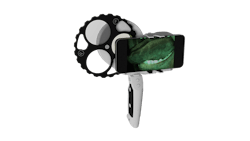Key Highlights
-
Nanohydroxyapatite toothpaste: Provides a natural, fluoride-free option that promotes enamel remineralization, while combination formulas like Dr. Jen’s Super Paste pair it with fluoride for enhanced cavity protection.
-
NIRI technology on iTero scanners: Near-infrared imaging detects interproximal caries without radiation, giving dentists precise, noninvasive diagnostic insight alongside traditional radiographs.
-
VELscope Mantis: Advanced fluorescence and reflectance imaging enhances oral cancer screenings, allowing clinicians to identify abnormal tissue early and document findings easily with smartphone integration.
Dr. Jen’s natural toothpastes
With the current administration, there’s been a lot of talk in the country about wanting to “make America healthy again.” I’ll admit, I don’t agree with almost anything the current administration is doing, but I do think the sentiment behind that phrase is something nearly everyone can get behind. After all, who doesn’t want a healthier America? It’s a good, decent goal that no reasonable person could argue against.
That said, there’s a curious irony when it comes to health in dentistry—many of the folks who rally behind “make America healthy again” are often antifluoride. And honestly, that drives me nuts. Fluoride is one of the most effective ways we have to prevent tooth decay. But I guess sometimes brainworms get into people’s heads and mess with their sense and reasoning.
When I have a patient who is antifluoride, it can make things tricky. I want to respect their views and still help them maintain good oral health. So how do you find common ground when you’re miles apart on such a fundamental issue? It’s not going to be over tariffs, immigration policy, or what to do about jets from Qatar. But maybe there’s a middle ground in the toothpaste aisle.
That’s where nanohydroxyapatite toothpaste comes into play. For patients who want fluoride-free options, nanohydroxyapatite is a fantastic alternative that promotes remineralization of teeth. I’ve been recommending Dr. Jen’s natural toothpastes to those patients who prefer to avoid fluoride. They come in two great flavors—strawberry and cool mint—and contain premium nanohydroxyapatite that helps repair enamel naturally. It’s science-backed and effective, and patients seem to like the taste.
For those patients who aren’t antifluoride, I point them to Dr. Jen’s Super Paste. This one combines nanohydroxyapatite with fluoride for a powerhouse defense against cavities. It’s like getting the best of both worlds, helping to strengthen teeth while preventing decay with proven fluoride benefits. I appreciate that Dr. Jen’s formulas avoid unnecessary additives and focus on what truly supports oral health.
In my practice, offering both options allows me to meet patients where they are and still promote the healthiest outcomes possible. It’s refreshing to find a toothpaste brand that respects the concerns some people have while maintaining a high standard of dental care. Plus, I feel good knowing I’m offering something that’s rooted in solid science.
I hope as a country we can find more middle ground in general—not just in toothpaste, but in the bigger debates that divide us. It feels like everything these days is contentious and polarized, and sometimes you just want to hand someone a tube of nanohydroxyapatite toothpaste and say, “Let’s start here.” Maybe if we can make small steps like that toward common goals, things will get a little less divisive.
At the end of the day, whether it’s oral health or national policy, making things healthier is something nearly everyone wants. It just takes a bit of patience, respect, and openness to find the best path forward. For me, Dr. Jen’s Natural Toothpastes are a practical example of that middle ground—a way to help people take care of their teeth in a manner that aligns with their values and concerns.
So, here’s to hoping more folks can find that kind of common ground and that we can all focus a little more on health and a little less on the noise. Because if we can get that right, then maybe making America healthy again is a goal worth fighting for.
NIRI technology on iTero scanners
I recently found my old CD binder from college while digging through some boxes. Man, flipping through those plastic sleeves filled with discs took me on a serious nostalgia trip. There were all my favorite albums—Oasis, Better Than Ezra, Hootie and the Blowfish. Those were the days when you actually bought music and carried around stacks of CDs. That’s how I used to consume music, painstakingly popping a disc into the player, waiting for it to load, and carefully rewinding if I wanted to hear a favorite track again.
Now, of course, things are way simpler. Streaming services have totally changed the game. I have every song I could ever want instantly accessible on my phone or computer—no waiting, no searching through a physical collection. It’s like always having a whole music store in my pocket. The access is broader, faster, and it’s hard to imagine going back to that old way of listening.
That shift reminds me a lot of how dentistry has changed since I started my career. Back then, we used film radiographs for every case. Film radiographs were such a pain, and the process of developing them felt like it took forever. There was an actual darkroom and chemicals involved—not exactly convenient when you’re trying to keep a schedule moving. On top of that, showing patients what you saw on a tiny black-and-white film was tough. It was hard to explain why a certain area was concerning or where caries was starting. The visuals didn’t really connect with patients, which made education and treatment acceptance a challenge.
Fast forward to now, and the technology we have blows the old film system out of the water. One of the coolest upgrades I’ve come across recently is the iTero scanners with NIRI technology. NIRI stands for near infrared imaging. What that means in practice is that the scanner can detect things like interproximal caries without exposing patients to any radiation. This is a huge step forward because it’s a noninvasive, safe, and efficient way to find those tiny incipient lesions hiding between teeth before they progress.
Instead of always relying on a possibly overlapped radiograph, the iTero scanner instantly gives you a 3D image of the tooth surface, and the NIRI technology adds another layer of depth by showing decay that’s hard to see otherwise. I can scan a patient’s mouth, immediately identify areas of concern, and then show those images right on the screen. This instant visual feedback makes educating patients easier—they can see the problem spots clearly, and that usually means they’re more engaged and open to treatment.
In my practice, NIRI does not routinely replace radiographs (unless the patient is pregnant); it is an adjunct to radiographs. The two layers of diagnostic imaging help us make sure we don’t miss anything and can always appropriately communicate what we see with our patients.
NIRI is available on the iTero 5D Plus and iTero Lumina scanners. This upgrade in technology feels a bit like moving from those clunky CDs to instant streaming. What used to be slow, cumbersome, and limited in its reach is now fast, precise, and user-friendly. Just as streaming opened a world of music to me on demand, the iTero scanner with NIRI opens a world of diagnostic insight right in my operatory.
Triple to the left field corner for Align and NIRI!
VELscope Mantis
I’ve been doing a full rewatch of all the Marvel movies lately. And by “all,” I mean the Infinity Saga. I stop at Endgame—because let’s be honest, things get kinda dicey after that. No disrespect to the multiverse or talking raccoons doing emotional monologues, but once I found myself sitting through a CGI celestial explaining the meaning of life, I knew I had overstayed my welcome.
What really stands out to me during these movies, aside from Chris Hemsworth’s biceps, is how handy all these superpowers would be in a dental office. I find myself thinking, “If I had Ant-Man’s shrinking tech, I could probably fit two more ops in this hallway.” Or how teleportation would’ve saved me about 6,000 steps a day in my old office layout.
But one character I keep coming back to is Hawkeye. He doesn’t have magic or a vibranium suit, but the guy can see a fly land on a target three zip codes away. That kind of super vision would be ridiculously helpful in dentistry. Exams, crown margins, caries detection—heck, just finding that tiny void in a temp you somehow missed until the patient was halfway out the door. But where it would really shine? Oral cancer screenings. Unfortunately, I wasn’t gifted with superhero eyeballs. But the VELscope Mantis gives me the next best thing.
This isn’t just another light for your operatory. The VELscope Mantis takes tissue visualization to another level. It lets you go beyond what you can see with the naked eye—fluorescence and reflectance imaging that can help identify potentially abnormal tissue before it becomes something more serious. You don’t need to switch to different glasses or flashlights or fiddle with filters … it’s just one device that gives you multiple views in real time.
What really makes the Mantis stand out, though, is the smart, real-world features they’ve built into it. One of my favorites? You can use your iPhone with the device to capture photos during your oral cancer screening exam. That’s incredibly useful for documentation, referrals, or just tracking lesions over time. There’s no extra software or complicated camera setup. Just snap your phone in, and it’s ready to go. Patients like seeing those images too. It turns a routine screening into a moment of real patient education and connection.
The device is cordless, light, and ergonomically built, which means it doesn’t feel like you’re wrestling with an unwieldy piece of equipment while trying to finish your hygiene check. The controls are intuitive, and the lighting is bright without being harsh. Plus, the polarized reflectance mode cuts through glare and lets you see inflammation or vascular patterns clearly.
It integrates seamlessly into the exam—you’re not adding minutes to the patient appointment, but you are adding value. That’s a win for both you and your patients.
I don’t have Hawkeye’s eagle eyes, but with the VELscope Mantis in my hands and an iPhone snapped in to capture what I see, I’m doing the next best thing—giving my patients an exam backed by technology that sees beyond the surface.
VELscope Mantis? That’s a sharp line drive into the left-center gap for extra bases. A solid piece of hitting!
Editor's note: This article appeared in the October 2025 print edition of Dental Economics magazine. Dentists in North America are eligible for a complimentary print subscription. Sign up here.
About the Author
Joshua Austin, DDS, MAGD
Joshua Austin, DDS, MAGD, is a graduate and former faculty member of the University of Texas Health Science Center at San Antonio School of Dentistry. Author of Dental Economics’ Pearls for Your Practice column, Dr. Austin lectures nationally on products, dental technology, online reputation management, and social media. He maintains a full-time restorative dentistry private practice in San Antonio, Texas. You may contact Dr. Austin at [email protected].
Updated June 21, 2023

